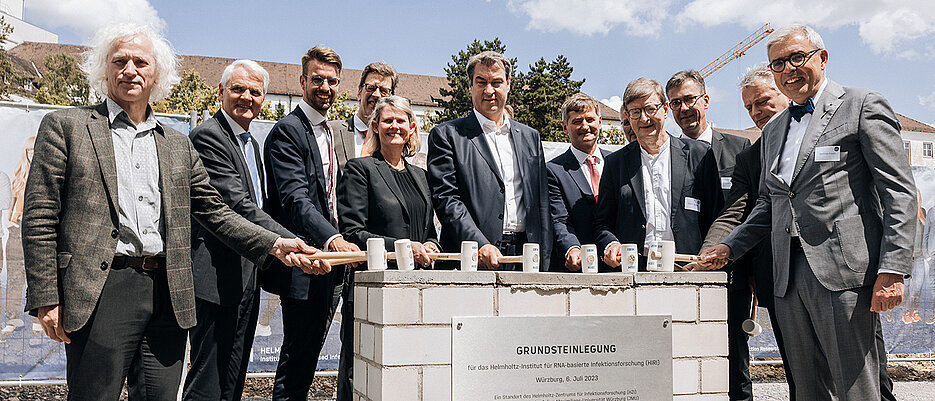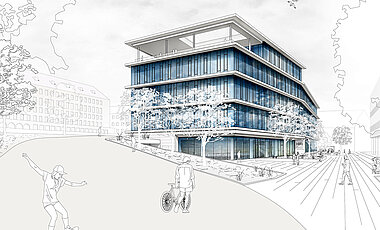New building for infection research
07/11/2023The Helmholtz Institute for RNA-based Infection Research celebrated the laying of the foundation stone on the Medical Campus in Würzburg. More than 200 guests from science, business, politics and the media were present.

Emerging pathogens, increasing antibiotic resistance and chronic infections are among the greatest health challenges of our time. With the aim of developing new strategies and therapies against known and novel infectious diseases, the Würzburg Helmholtz Institute for RNA-based Infection Research (HIRI) was founded in May 2017. The institute is pioneering an integrated approach to investigate the great potential of ribonucleic acids (RNA) in therapy and diagnostics.
Currently still housed provisionally in premises of the JMU, HIRI’s own building—funded by the Free State of Bavaria, represented by the State Ministry of Economic Affairs, Regional Development and Energy, and co-financed by the European Union—will be constructed and help permanently fulfill its research mission in Würzburg. The groundbreaking ceremony on July 6, 2023 marked the start of construction work on the medical campus in Würzburg's Grombühl district.
„In terms of medicine, RNA technology offers some of the greatest opportunities for mankind“
In his address to more than 200 guests from science, business, politics and the media, Bavaria's Minister President Markus Söder highlighted the importance of research in Würzburg for the Free State's future and innovation strategy: "Research and science are a high priority in the Free State of Bavaria. We are investing in the future: The new building for HIRI and its infection research will provide space for 130 employees by 2026. In the future, almost 5,000 square meters will be available to conduct science for the benefit of society. In terms of medicine, RNA technology offers some of the greatest opportunities for mankind. Through our high-tech agenda, the Free State of Bavaria is investing more than 5.5 billion euros in science and research—more than any other German state. Good luck to medical research in Würzburg!"
State Secretary Roland Weigert from the Bavarian Ministry of Economic Affairs, Regional Development and Energy wished the construction project every success and emphasized: "The pandemic years have shown us the crucial importance of outstanding basic research for the development of diagnostics and therapy in the field of infectious diseases. This research excellence requires bright minds as well as a cutting-edge working environment."
Building will ensure future research
Otmar D. Wiestler, President of the Helmholtz Association, Josef Penninger—who also introduced himself to the guests as the new Scientific Director of the HZI—and Jörg Vogel, Managing Director at the Würzburg HIRI, expressed their gratitude to the funders. They allow research at the highest level. And the new building plays an important part in this, said Vogel: "After six years of growth at our institute, we lack sufficient space and laboratory capacities in our interim domicile."
Rainer Post, managing director of doranth post architekten, the firm commissioned with the design of the new building, demonstrated that the architectural concept provides the best preconditions for a lively research environment and intensive scientific exchange
The new building at a glance
In 2018, an architectural competition was held with the objective of creating a new building for the Helmholtz Institute Würzburg that would be future-oriented and cost-effective. The contract was awarded to doranth post architects, an architectural firm based in Munich. The firm is working in Germany and abroad and has successfully completed multiple buildings for scientific institutions, including in Bavaria, for example in Munich and Erlangen.
The design for the new HIRI building envisions a slender, longitudinally oriented structure that harmonizes with its surroundings on the medical campus in terms of shape and size. At the same time, the institute's transparent glass façade, its open main staircase flooded with natural light and its fragmented cubature establish a contemporary juxtaposition to the adjacent historic buildings dating to the Wilhelminian period.
A striking feature of the construction is the west-facing top section of the building, which is designed as a fifth floor and highlights the autonomy of the Helmholtz Institute within the campus. It also serves as a meeting place and venue for events.
The rooftop terrace, oriented towards the west, offers numerous views of Würzburg’s architectural landmarks. The front of the building is directed towards Josef-Schneider-Straße, promoting the location and establishing a well-proportioned public square that acts as gathering space and connection point to the Institute for Molecular Infection Biology and the Rudolf Virchow Center, located across the way. This new square also ensures easy accessibility to the building and its first-floor seminar rooms.








